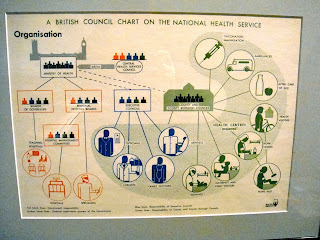The Wallace Collection like many small private historical collections that has become a public gallery probably uses the same frames the original collectors used. These ornate frames often included a plaque with the artist, title or subject of the piece, and date of creation. The Wallace Collection seems to have replaced most of these tags (because they include a catalog number) instead of putting separate labels on the walls. I think this was a good decision because it is more in keeping with the historical experience, it encourages a less museum/institutional feeling, and most practically it prevents any damage to the walls. Generally I prefer a separate panel, even in addition to a plaque label, just for additional information, but in this setting you aren't necessarily looking for an art education just the experience of seeing the collection. And it's nice not having to avert your eyes far from the painting to find out the artist so you can stay visually engaged with it.
OBJECT OF APPRECIATION
 I was surprising interested in the armor and weaponry collection, it's fascinating that there can be so many lavish imaginations of the same thing. The heads of axes and the butts of rifles were extraordinary at times but I would love to return to my dear Bronzino because the Wallace Collection has a portrait from the studio of Bronzino of Eleonora of Toledo - perhaps a study for a later portrait of Eleonora with her son by Bronzino. I'm not totally sure why his works appeal to me so much, the expressions could be interpreted as blank but I like to think they are just sort of far away and immersed in their thoughts. Of course I have to mention Eleonora's luxurious dress and adornments, gorgeous! In the few minutes I have spent looking up the painting I have discovered her dress features a pomegranate motif symbolizing fertility, and it is thought that Eleonora started a trend of wearing pearl drop earrings with these portraits, and that her husband Cosimo de Medici I (Duke of Florence and later Tuscany), made her regent while he was away from home. This information encourages me to research more and appreciate the art more.
I was surprising interested in the armor and weaponry collection, it's fascinating that there can be so many lavish imaginations of the same thing. The heads of axes and the butts of rifles were extraordinary at times but I would love to return to my dear Bronzino because the Wallace Collection has a portrait from the studio of Bronzino of Eleonora of Toledo - perhaps a study for a later portrait of Eleonora with her son by Bronzino. I'm not totally sure why his works appeal to me so much, the expressions could be interpreted as blank but I like to think they are just sort of far away and immersed in their thoughts. Of course I have to mention Eleonora's luxurious dress and adornments, gorgeous! In the few minutes I have spent looking up the painting I have discovered her dress features a pomegranate motif symbolizing fertility, and it is thought that Eleonora started a trend of wearing pearl drop earrings with these portraits, and that her husband Cosimo de Medici I (Duke of Florence and later Tuscany), made her regent while he was away from home. This information encourages me to research more and appreciate the art more.OBJECT OF EXCESSIVE DETAILS
In one room of the Wallace Collection there is a fabulous chandelier, I saw it and right away I thought "Object of excessive ornamentation? Check!" When I went to look for an information panel I saw a different label that intrigued me: 'Pair of Tripod Candelabra with goats' heads and feet with candleholders in the mouths of snakes.' I don't know if I need say more on this subject, perhaps just let them speak for themselves but I have to say I found these candelabra pretty hilarious and just so random. People were weird.
FAVORITE MUSEUM
My favorite museum visit this semester was probably the visit to the Saatchi Gallery. I really like this gallery, it's a really lovely environment with some interesting art. Because of Saatchi's mission to have people draw their own conclusions about the work it was great to have a guided tour to explain some of the work that I had previously seen and not understood. As a student working towards a BFA of course I am especially interested in contemporary art and the Saatchi is one of few prominent locations to see new working artists without an intimidating setting.
MUSEUM INTEREST
I can't say my interest in visiting museums has increased after this course, because I have always considered art museums an important part of my life and an important part of visiting a new place. I do think it has made me a bit more willing to visit types of museums other than art museums.
Similarly, I have had an interest in museum branding and design for a few years but the course was helpful in putting me in a critical mindset during the museum visits for class. And art doesn't scare me, art is fun! And it can be whatever you want!
Similarly, I have had an interest in museum branding and design for a few years but the course was helpful in putting me in a critical mindset during the museum visits for class. And art doesn't scare me, art is fun! And it can be whatever you want!
COMMENTS
Thanks for all the effort you put into arranging visits, and writing thought-provoking questions. Thanks most of all for arranging a class visit to the Design Museum so I didn't have to pay for a place I already wanted to go to!

































